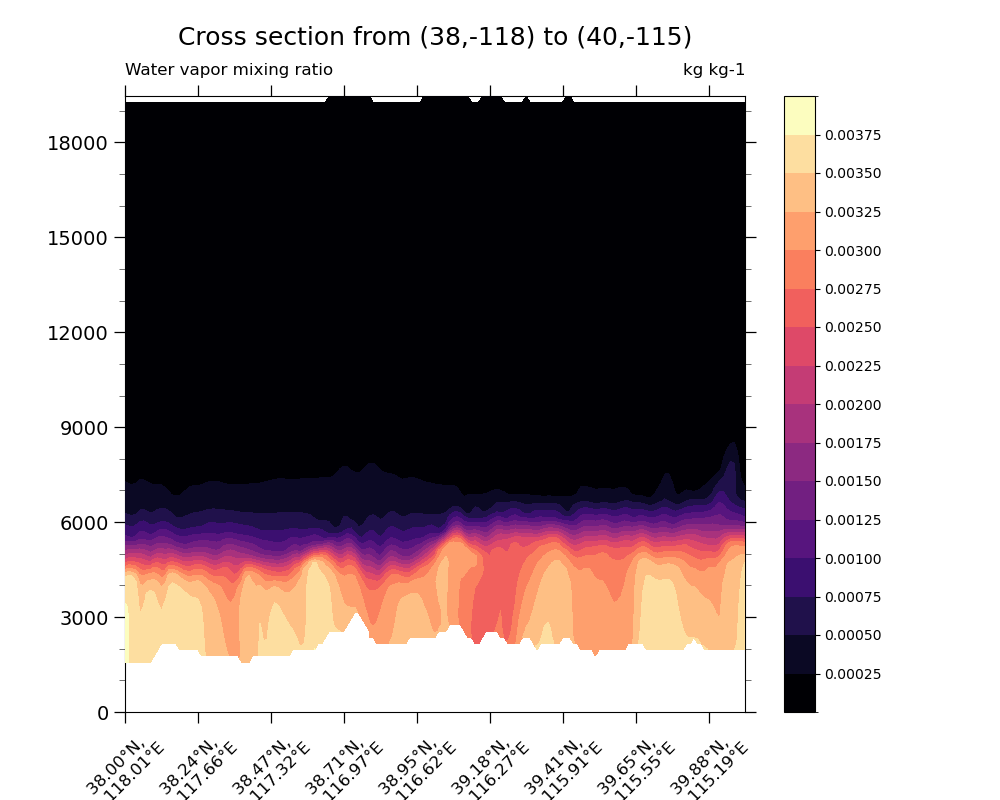Note
Go to the end to download the full example code
NCL_WRF_interp_3.py#
- This script illustrates the following concepts:
Interpolating a vertical cross-section from a 3D WRF-ARW field.
Recombining two datasets into one usable form
Following best practices when choosing a colormap. More information on colormap best practices can be found here.
- See following URLs to see the reproduced NCL plot & script:
Original NCL script: https://www.ncl.ucar.edu/Applications/Scripts/wrf_interp_3.ncl
Original NCL plot: https://www.ncl.ucar.edu/Applications/Images/wrf_interp_3_lg.png
Import packages
from netCDF4 import Dataset
import numpy as np
import matplotlib.pyplot as plt
import xarray as xr
import os
from wrf import (to_np, getvar, CoordPair, vertcross, latlon_coords)
import geocat.datafiles as gdf
import geocat.viz as gv
Read in the data
# Specify the necessary variables needed from the data set in order to use 'z' and 'QVAPOR'
toinclude = ['PH', 'P', 'HGT', 'PHB', 'QVAPOR']
# Read in necessary datasets
ds = xr.open_mfdataset([
gdf.get('netcdf_files/wrfout_d03_2012-04-22_23_00_00_Z.nc'),
gdf.get('netcdf_files/wrfout_d03_2012-04-22_23_00_00_QV.nc')
])
# specify a unique output file name to use to read in combined dataset later
file3 = 'wrfout_d03_2012-04-22_23.nc'
mrg = ds[toinclude].to_netcdf(file3)
# Read in the data and extract variables
wrfin = Dataset(('wrfout_d03_2012-04-22_23.nc'))
z = getvar(wrfin, "z")
qv = getvar(wrfin, "QVAPOR")
# Pull lat/lon coords from QVAPOR data using wrf-python tools
lats, lons = latlon_coords(qv)
Create vertical cross section using wrf-python tools
# Define start and stop coordinates for cross section
start_point = CoordPair(lat=38, lon=-118)
end_point = CoordPair(lat=40, lon=-115)
qv_cross = vertcross(qv,
z,
wrfin=wrfin,
start_point=start_point,
end_point=end_point,
latlon=True)
# Close 'wrfin' to prevent PermissionError if code is run more than once locally
wrfin.close()
# Remove created wrfout file from local directory
os.remove('wrfout_d03_2012-04-22_23.nc')
Plot the data
fig = plt.figure(figsize=(10, 8))
ax = plt.axes()
# Set the x-ticks to use latitude and longitude labels.
coord_pairs = to_np(qv_cross.coords["xy_loc"])
x_ticks = np.arange(coord_pairs.shape[0])
# Plot filled contours
qv_contours = qv_cross.plot.contourf(ax=ax,
levels=17,
cmap='magma',
vmin=0,
vmax=0.004,
zorder=4,
add_labels=False,
add_colorbar=False,
yticks=np.arange(0, 20000, 3000),
xticks=x_ticks[::20])
# Add colorbar
plt.colorbar(qv_contours, ax=ax, ticks=np.arange(0.00025, 0.004, .00025))
# Add minor ticks to the yaxis
gv.add_major_minor_ticks(ax=ax,
x_minor_per_major=1,
y_minor_per_major=3,
labelsize=14)
# Format the xtick labels
x_labels = [
pair.latlon_str(fmt="{:.2f}\N{DEGREE SIGN}N, \n {:.2f}\N{DEGREE SIGN}E")
for pair in to_np(coord_pairs)
]
ax.set_xticklabels(x_labels[::20], rotation=45, fontsize=12)
# Set the plot titles
plt.title("Cross section from (38,-118) to (40,-115)", fontsize=18, y=1.07)
plt.title('Water vapor mixing ratio', loc='left', y=1.02)
plt.title('kg kg-1', loc='right', y=1.02)
plt.show()

Total running time of the script: (0 minutes 3.818 seconds)